AMD's Radeon HD 5870: Bringing About the Next Generation Of GPUs
by Ryan Smith on September 23, 2009 9:00 AM EST- Posted in
- GPUs
Cypress: What’s New
With our refresher out of the way, let’s discuss what’s new in Cypress.
Starting at the SPU level, AMD has added a number of new hardware instructions to the SPUs and sped up the execution of other instruction, both in order to improve performance and to meet the requirements of various APIs. Among these changes are that some dot products have been reduced to single-cycle computation when they were previously multi-cycle affairs. DirectX 11 required operations such as bit count, insert, and extract have also been added. Furthermore denormal numbers have received some much-needed attention, and can now be handled at full speed.
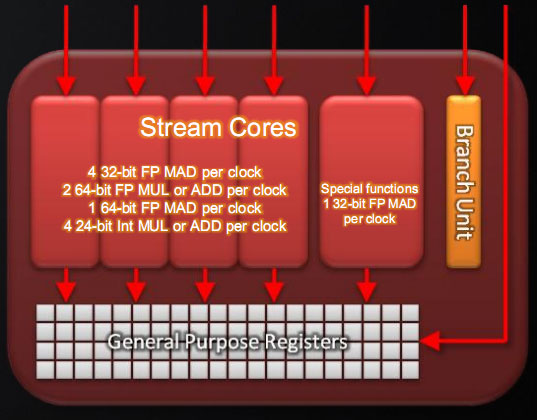
Perhaps the most interesting instruction added however is an instruction for Sum of Absolute Differences (SAD). SAD is an instruction of great importance in video encoding and computer vision due to its use in motion estimation, and on the RV770 the lack of a native instruction requires emulating it in no less than 12 instructions. By adding a native SAD instruction, the time to compute a SAD has been reduced to a single clock cycle, and AMD believes that it will result in a significant (>2x) speedup in video encoding.
The clincher however is that SAD not an instruction that’s part of either DirectX 11 or OpenCL, meaning DirectX programs can’t call for it, and from the perspective of OpenCL it’s an extension. However these APIs leave the hardware open to do what it wants to, so AMD’s compiler can still use the instruction, it just has to know where to use it. By identifying the aforementioned long version of a SAD in code it’s fed, the compiler can replace that code with the native SAD, offering the native SAD speedup to any program in spite of the fact that it can’t directly call the SAD. Cool, isn’t it?
Last, here is a breakdown of what a single Cypress SP can do in a single clock cycle:
- 4 32-bit FP MAD per clock
- 2 64-bit FP MUL or ADD per clock
- 1 64-bit FP MAD per clock
- 4 24-bit Int MUL or ADD per clock
- SFU : 1 32-bit FP MAD per clock
Moving up the hierarchy, the next thing we have is the SIMD. Beyond the improvements in the SPs, the L1 texture cache located here has seen an improvement in speed. It’s now capable of fetching texture data at a blistering 1TB/sec. The actual size of the L1 texture cache has stayed at 16KB. Meanwhile a separate L1 cache has been added to the SIMDs for computational work, this one measuring 8KB. Also improving the computational performance of the SIMDs is the doubling of the local data share attached to each SIMD, which is now 32KB.
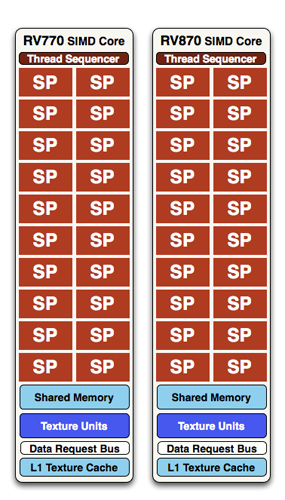
At a high level, the RV770 and Cypress SIMDs look very similar
The texture units located here have also been reworked. The first of these changes are that they can now read compressed AA color buffers, to better make use of the bandwidth they have. The second change to the texture units is to improve their interpolation speed by not doing interpolation. Interpolation has been moved to the SPs (this is part of DX11’s new Pull Model) which is much faster than having the texture unit do the job. The result is that a texture unit Cypress has a greater effective fillrate than one under RV770, and this will show up under synthetic tests in particular where the load-it and forget-it nature of the tests left RV770 interpolation bound. AMD’s specifications call for 68 billion bilinear filtered texels per second, a product of the improved texture units and the improved bandwidth to them.
Finally, if we move up another level, here is where we see the cause of the majority of Cypress’s performance advantage over RV770. AMD has doubled the number of SIMDs, moving from 10 to 20. This means twice the number of SPs and twice the number of texture units; in fact just about every statistic that has doubled between RV770 and Cypress is a result of doubling the SIMDs. It’s simple in concept, but as the SIMDs contain the most important units, it’s quite effective in boosting performance.
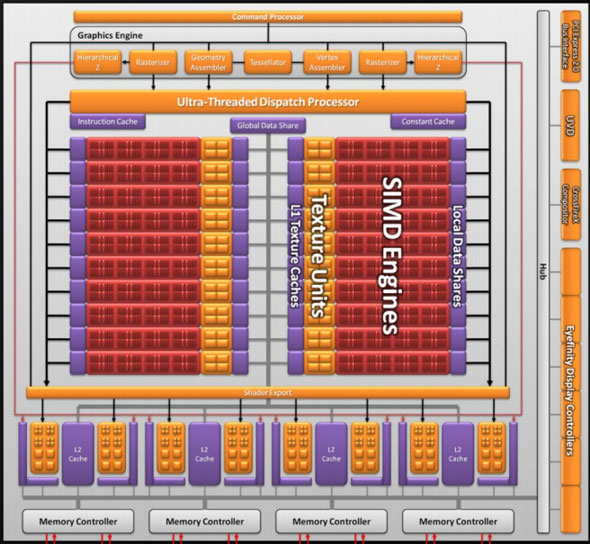
However with twice as many SIMDs, there comes a need to feed these additional SIMDs, and to do something with their products. To achieve this, the 4 L2 caches have been doubled from 64KB to 128KB. These large L2 caches can now feed data to L1 caches at 435GB/sec, up from 384GB/sec in RV770. Along with this the global data share has been quadrupled to 64KB.
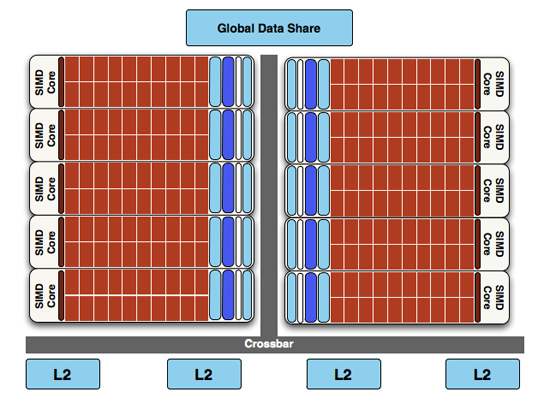
RV770 vs...
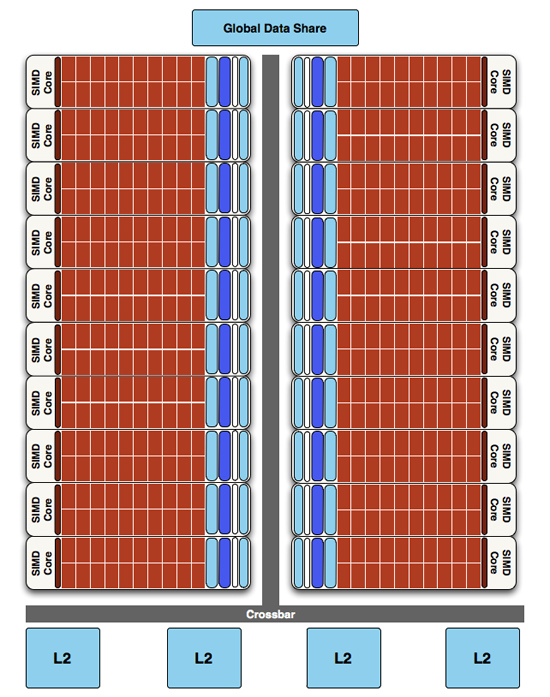
Cypress
Next up, the ROPs have been doubled in order to meet the needs of processing data from all of those SIMDs. This brings Cypress to 32 ROPs. The ROPs themselves have also been slightly enhanced to improve their performance; they can now perform fast color clears, as it turns out some games were doing this hundreds of times between frames. They are also responsible for handling some aspects of AMD’s re-introduced Supersampling Anti-Aliasing mode, which we will get to later.

Last, but certainly not least, we have the changes to what AMD calls the “graphics engine”, primarily to bring it into compliance with DX11. RV770’s greatly underutilized tessellator has been upgraded to full DX11 compliance, giving it Hull Shader and Domain Shader capabilities, along with using a newer algorithm to reduce tessellation artifacts. A second rasterizer has also been added, ostensibly to feed the beast that is the 20 SIMDs.










327 Comments
View All Comments
Qfromchicago - Friday, November 27, 2009 - link
Windows 7 ProfessionOnkyo 805
Diamond 5870
Still no 3rd option for hd audio.
Has anyone been able to work this thing
charme - Friday, November 27, 2009 - link
same here.no 3rd option for hd audio
otni - Sunday, November 29, 2009 - link
YES, WORKING PERFECT FOR ME...TRY THIS: PLAY THE BLUE-RAY MOVIE THEN GO TO SETTING ON POWERDVD AND CHARGES TO THE 3ER OPTION FOR HD SOUND.IS WORKING FOR ME, THANKS CYBERLINK
FlyTexas - Saturday, November 14, 2009 - link
What good does it do to launch this, if there are still none for sale a month later?Yes, I know there were a few sold up front, but NewEgg has been out for awhile...
RavnosCC - Tuesday, November 17, 2009 - link
The 57xx series are readily available, they also support HD Audio.RavnosCC - Monday, November 23, 2009 - link
"As of today, new PowerDVD 9 Ultra customers will receive build 2320, which includes support for HDMI bitstreaming of undecoded (full quality) audio with ATI Radeon 5000 series graphics cards, and the Auzentech X-Fi Hometheater HD sound card. An update patch for current owners of PowerDVD 9 Ultra is scheduled to be available next Friday (11/27).Tom
Cyberlink"
Qfromchicago - Wednesday, November 25, 2009 - link
Though happy that finally we will get hd audio using powerdvd, but why limit it to new customers only. It seems to me that if you can offer it to new customers, you should be able to offer it to everyone at the same time.Qfromchicago - Sunday, October 18, 2009 - link
I have win 7, a diamond 5870, powerdvd 9 ultra version 2201 and still I don't get he 3rd choice for the HD audio bitstreaming. Has anyone been able to get bitstreaming to work with powerdvd 9. ThanksRavnosCC - Thursday, November 5, 2009 - link
UPDATE: Looks like late November for the mythical patch..."Hi everyone,
Yes... we read these forums regularly. Feedback is forwarded to the appropriate people. These forums aren't the best way for us to provide customer support, so if you have an issue, please open a support ticket through our website.
We can't always comment on new developments... or at least we like to wait until we have a definite answer. I know everyone noticed the reviews for the ATI Radeon 5000 series graphics cards, where certain reviewers were using a pre-release version of PowerDVD 9 to demonstrate HDMI bitstreaming of Blu-ray audio. Support for this feature will be in the next PowerDVD update (patch), which will be available later this month. I don't have a firm date on this, but we're trying to expedite it. Please keep in mind that each of our regular updates includes fixes for new BD titles and new (or forthcoming) hardware / drivers across the PC ecosystem, and so the feature you are anxiously waiting for isn't the only thing that we need to include in the update. Of course, each update has to go through a full quality assurance testing procedure, to make sure that none of the changes introduced any new issues.
So... sorry for going quiet on you... but I and others read every post in this thread and other relevant threads, following up as needed (in some cases, directly through private messages on these forums).
Tom
Cyberlink"
RavnosCC - Wednesday, October 28, 2009 - link
I am in the same boat, with Vista, I have powerdvd 9 ultra fully patched and still no third option for hi-def passthrough... :-/